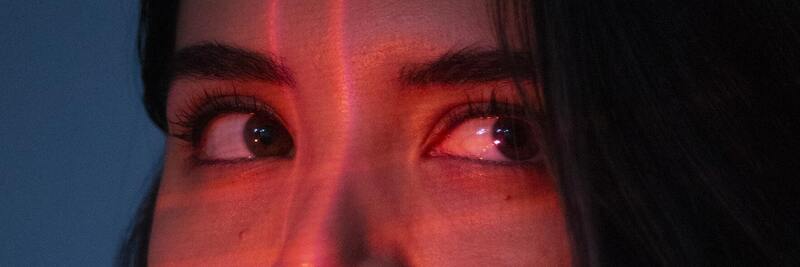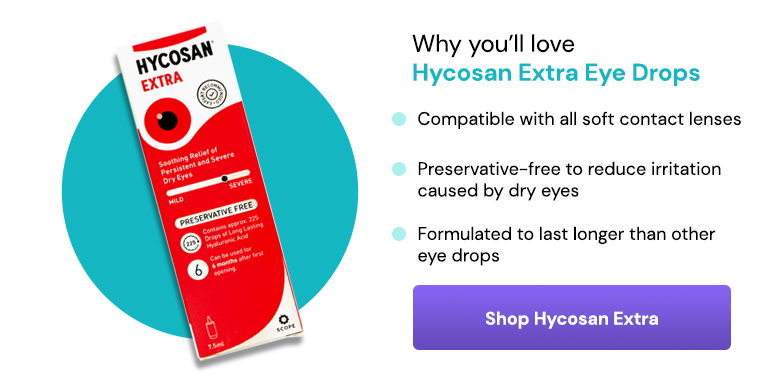Causes for eye pain
Which conditions can cause eye pain?
Eye pain is often used as an umbrella term for all types of discomfort around the eye area. It can be expressed in various stages of intensity, from mild irritation and sore eyes to a sharp pain in or around the eyes.
The professional term for eye pain, ophthalmalgia, is used to describe pain in the eyeball, but even here there are differences in severity to consider.
Depending on the type of eye pain you are experiencing, it might not be indicative of serious health concerns. Sore or irritated eyes typically calm down after a few hours of rest, however, it is always best to contact your optometrist if any discomfort lasts over several hours.
Eye pain can be caused by eye conditions but also other medical conditions that affect your eye health.
Eye conditions
In most cases, eye pain is caused by a health condition that directly affects the eyes. This can be as a result of viral or bacterial infections or inflammation of the eyes, such as blepharitis, conjunctivitis (pink eye) or iritis. Another cause for eye pain can be an injury, surgery or foreign bodies entering the eye, such as debris or landscaping matter.
Genetic eye conditions such as glaucoma are not only serious conditions that should be treated as soon as possible to avoid vision loss, they can also be causes for pressure pain in the eye.
Other health conditions
Sometimes, pain around the eye area is caused by a medical condition that affects other parts of the body, such as sinus infections, allergies or migraines. Even toothache is connected to nerves running past the eye area and can create discomfort around the sensitive organ.

Where is the pain located?
Discomfort or pain can be in different areas of the eye, either on the surface, inside the eye, behind the eye or around the eye. The perception of where the pain is located can differ for each individual person affected.
On the surface (ocular)
Pain on the surface of the eye, is often caused by a foreign body or injury, but it can also be the symptom of an infection.
Foreign body
Everyone has probably felt dust, particles of make-up or an eyelash in their eyes at some point, alongside that sore and gritty feeling. Foreign bodies can rub against the cornea or conjunctiva, leading to a bloodshot eye.
This is a common cause for eye pain and no reason for concern. Avoid rubbing your eyes when you experience foreign body discomfort and try flushing the particles out with saline or lubricating eye drops. It is also recommended to see your optometrist if the symptoms persist.
Blepharitis
Blepharitis is a common condition that affects the eyelids, causing them to swell up, feeling irritated and itchy. Because of the swollen eyelid, the front surface of your eye may feel sore and dry.
In rare cases, blepharitis causes eyelashes to grow inwards, which can scratch the cornea.
Stye
A stye is a small red lump on the upper or lower eyelid and often appears alongside blepharitis. It is painful rather to the eyelid than the eye, as the area is swollen and tender to touch. A stye should not cause any concern and typically resolves within a few weeks.
Allergies
Pollen, pets or dust cause allergic reactions to the eyes, often referred to as allergic conjunctivitis. This reaction causes red and itchy eyes and may be accompanied by a sensitivity to light.
Whether the allergies are seasonal or affect you year-round, eye drops, or cold compresses can help relieve the discomfort.

Corneal abrasion
More commonly known as a scratched cornea, this condition occurs when the front surface of your eye is compromised, often by rubbing it or from a foreign body. The cornea contains nerves which are sensitive to touch, and therefore a simple scratch can hurt a lot more than it would on the skin.
Corneal abrasions can be treated with preservative free lubricating drops, as it helps with the wound healing process of the corneal epithelium and keeps the eyes comfortable.
Depending on how deep the abrasion is, in rare cases antibiotics may be advised to prevent secondary infections.
In the eye (orbital)
Pain or pressure in the eye can be caused by several diseases and infections or signifies an injury.
Injuries
Trauma injuries are likely to occur during sports or accidents, whether a ball hits your face, or you fall down the stairs. These can cause significant damage to the eye, resulting in the pain being perceived inside the eye. When you feel intense pain, seek medical attention immediately to ensure your eye health and vision is not at serious risk.
Glaucoma
Glaucoma is a common eye condition that can be passed on through genetics and causes fluid to build up in the eye, leading to increased pressure in the eye. Acute angle closure glaucoma is a less common form of glaucoma but causes the eye pressure to increase rapidly, leading to pain inside the eye.
If left untreated, any type of glaucoma can lead to vision loss, so contact your optometrist immediately if you feel intense pressure in one of your eyes.
Iritis
Iritis is an inflammation of the coloured part of your eye (iris), typically not caused by any catalyst, but may follow autoimmune diseases or infections. In addition to light sensitivity and headaches, it causes a deep eye pain.
Optic neuritis
Optic neuritis is an inflammation of the optic nerve, a condition that can be caused by bacterial and viral infections or multiple sclerosis. It causes dull pain and discomfort in the eye, that increases with eye movements.
Behind the eye
Pain behind the eye is typically not a sign of a serious condition directly related to your eye health, but rather another medical condition.
Sinus infection
Sinusitis is an infection that causes the sinuses to swell up. This causes pressure in the upper portion of the face, often with pain especially focussed behind the eyes. Sinus infections are no serious cause for concern and typically subside without medical assistance.
Migraines
Migraines are intense headaches, often accompanied by nausea, temporary light sensitivity and at times, visual disturbance. The pain typically centres behind the eyes, with a pulsating pressure. There is no treatment for migraines, except painkillers and, they usually disappear after several hours.
Toothache
Toothache in the upper teeth can cause pain that rises and settles behind the eyes. As this type of eye pain is a side effect of dental conditions, it is best to seek help from your dentist.

How to relieve eye pain
The best solution to relieve eye pain is by treating the condition causing it. However, there are a few options for immediate eye pain relief.
Warm or cold compress
A towel moistened with warm water can help keep the eyes clean and free of any blockages causing discomfort. A cold compress can reduce swelling and help to numb the pain.
Eye drops
Lubricating or wetting eye drops can be used to flush the eyes and thereby remove any possible irritants.
Resting your eyes
- Give your eyes a break from staring at screens, remove your Lenstore contact lenses and try to take several breaks over the day. Well rested eyes will reduce the risks of eye strain and relieve eye pain over long periods of time.
When to seek medical help
Most cases of eye pain are no cause for concern and will fade without medical assistance. The underlying conditions causing the eye pain are not always factors that damage your eye health, but if the pain is persistent and is accompanied by other symptoms, immediate action should be taken.
Other symptoms could be sudden changes to your vision or light sensitivity. If you notice any of these or if your eye pain develops after an injury, seek medical assistance immediately.
Article originally posted in March 2021. It has since been updated.







